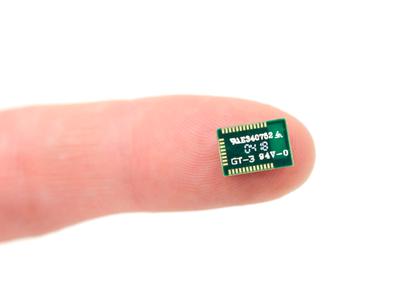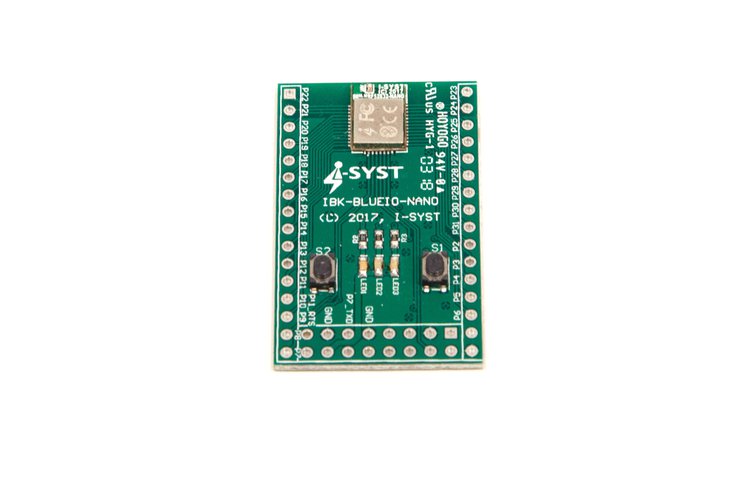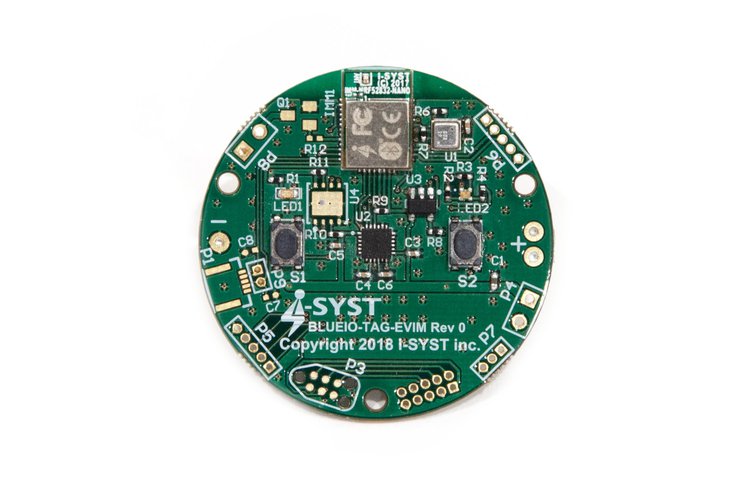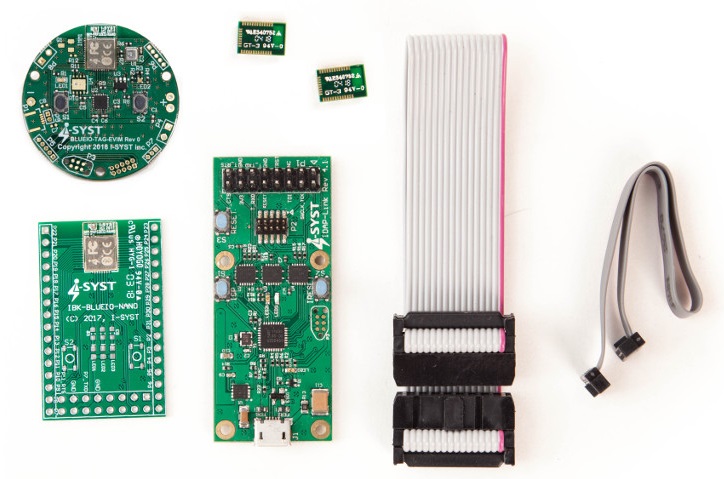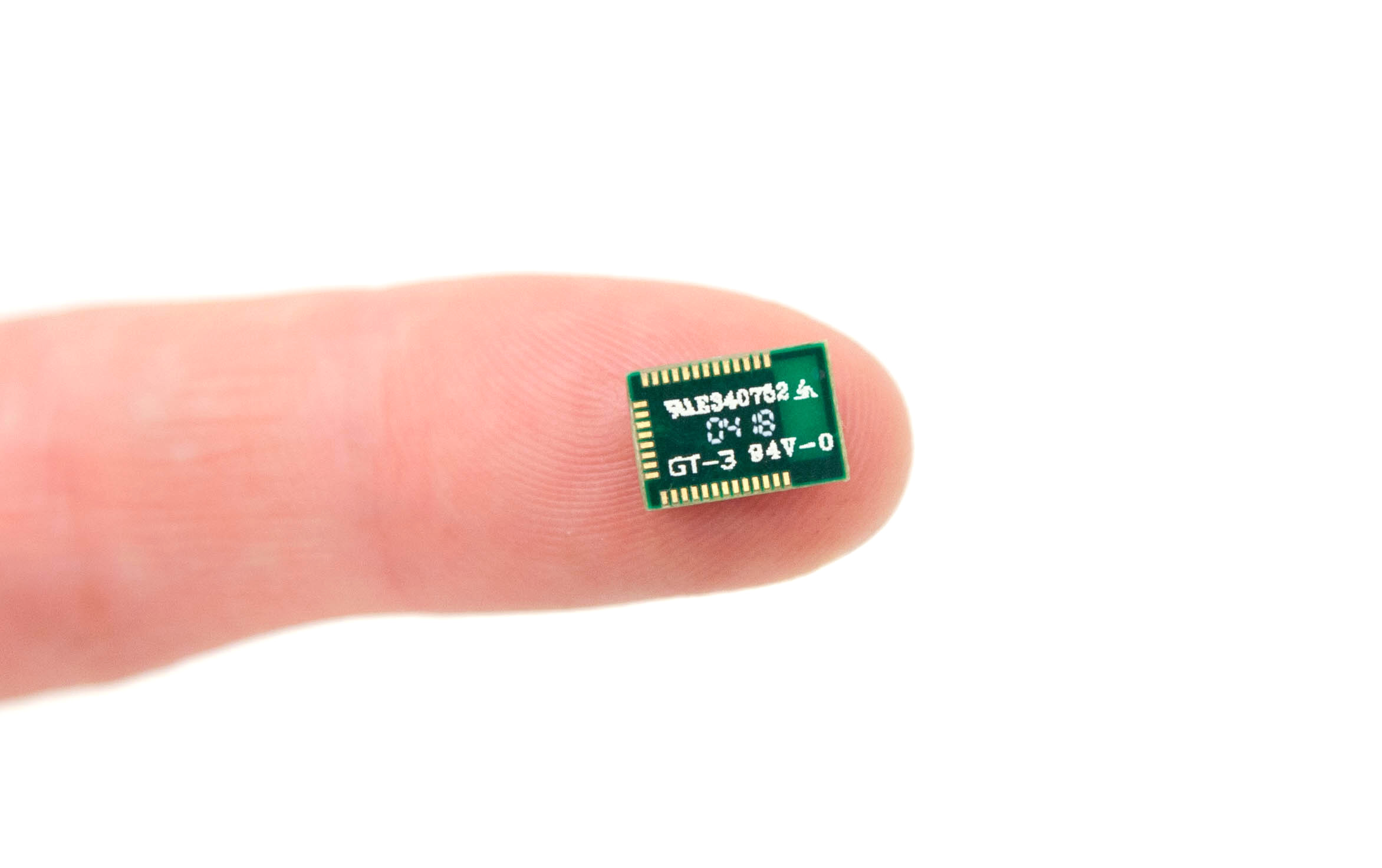IMM-NRF52832-NANO (BLYST Nano)
Fingertip size Bluetooth® 5 Module
With a design based on the Nordic nRF52832 SoC, combining a low power 64 MHz ARM Cortex-M4F and the 2.4 GHz radio in a single chip, the BLYST Nano SoM (System on Module) is the perfect way to catch this new Bluetooth IoT wave driven by both Bluetooth® 5 and Bluetooth® Mesh.
- The BLYST Nano is low power and small enough, at 10 x 7 x 1.6 mm, for wearable and sensor applications.
- With 30 programmable I/O pins, it's versatile enough to fit any control and automation application.
- With a hardware floating-point unit, algorithms can be directly implemented on the device, allowing more real-time sensor fusion processing.
- It is a complete System on the Module with all required components (crystals, coils, DC/DC, etc.) built-in and ready to use. So you don't need to take up more board space with add-on components needed to support a given module.
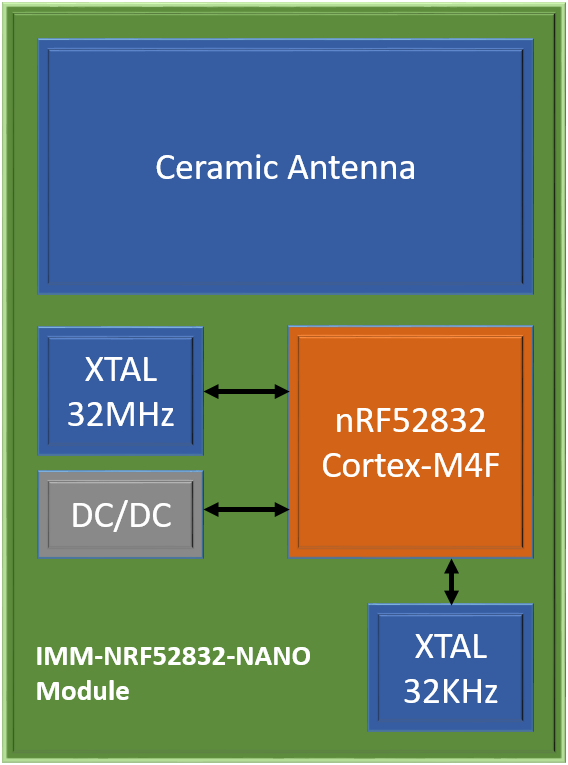
BLYST Nano Module Features
- Built-in ceramic antenna
- Built-in coils for low power DC/DC mode
- Built-in 32 MHz & 32.768 MHz crystal for low power
- Dimensions: 10 x 7 x 1.6 mm
- No extra PCB spaces or any external components required on users' application board
- All I/O pins of the nRF52832 are exposed to pads around the edges of the module to take full advantage of the nRF52832 and for easy assembly without compromise
- FCC & CE certified
nRF52832 Features
- Single-chip, highly flexible, 2.4 GHz multi-protocol SoC
- 32-bit ARM Cortex-M4F Processor
- 1.7 V to 3.6 V operation
- 512 kB flash + 64 kB RAM
- Supports concurrent Bluetooth low energy/ANT protocol operation
- On-chip NFC tag for Out-of-Band (OOB) pairing
- Up to +4 dBm output power
- -96 dBm sensitivity, Bluetooth Low Energy (BLE)
- Thread-safe and run-time protected
- Event-driven API
- On-air compatible with nRF24L and nRF24AP series
- 2 data rates (2 Mbps/1 Mbps)
- PPI - maximum flexibility for power-efficient applications and code simplification
- Automated power management system with automatic power management of each peripheral
- Configurable I/O mapping for analog and digital I/O
- 3 x Master/Slave SPI
- 2 x Two-wire interface (I²C)
- UART (RTS/CTS)
- 3 x PWM
- AES HW encryption
- 12-bit ADC
- Real-time Counter (RTC)
- Digital microphone interface (PDM)
|
Radio |
|
|
Band |
2.4 GHz ISM |
|
On-air datarate |
2 Mbps and 1 Mbps Bluetooth LE 1 Mbps ANT 2 Mbps and 1 Mbps 2.4 GHz proprietary |
|
Output power |
Programmable: +4 to -20 dBm in 4 dB steps |
|
Sensitivity |
-96 dBm Bluetooth LE 1 Mbps -89 dBm Bluetooth LE 2 Mbps -93 dBm 1 Mbps ANT -30 dBm whisper mode |
|
RSSI |
1 dB resolution |
|
Radio current consumption with DC/DC at 3V |
7.5 mA – TX at +4 dBm output power
|
|
Microcontroller |
|
|
CPU |
ARM Cortex M4 |
|
Floating Point Unit |
Yes |
|
Memory |
Flash 512 KB (+ cache) + 64 KB RAM Flash 256 KB (+ cache) + 32 KB RAM |
|
GPIO |
32 configurable |
|
Peripherals |
|
|
NFC |
NFC-A Tag |
|
ADC |
12-bit 200 ksps |
|
Comparators |
General purpose, low-power |
|
Interfaces |
SPI/2-wire/I²S/UART/PDM/QDEC |
|
Security |
AES-128/ECB/CCM/AAR |
|
Timers/Counters |
32-bit |
|
System |
|
|
System peripheral bus |
20-channel PPI |
|
Power supply |
Automatic system power DC/DC (1.7 V to 3.6 V), LDO (1.7 V to 3.6 V) |
|
System current consumption DC/DC at 3V |
0.3 μA – No RAM retention 1.2 uA – All peripherals in IDLE mode 1.6 uA – All peripherals IDLE mode (32 kHz + RTC) 20 nA per 4 KB - RAM retention |
|
Performance |
|
|
Coremark |
215 EEMBC CoreMark® (3.36 CoreMark/MHz) 58 CoreMark®/mA (Flash) |
|
Package options |
|
|
QFN48 |
6 x 6 with 32 GPIOs |
|
WLCSP50 |
3.0 x 3.2 with 32 GPIOs |
There are lots of software developement resources available for the nRF52832. It is well supported by the open source community, from beginning Arduino users to more advanced progammers. The Micropython port is also available for the BLYST Nano based boards.
- BLYST Nano Datasheet
- IDAP-Link documentation & software
- Nordic Bluetooth 5 SDK download
- Nordic Bluetooth Mesh SDK
- Nordic developer forum
- Setting up Eclipse GCC based firmware development environment
- IOsonataIDE_SDK_Setup installation program
- Micropython port for the BLYST Nano
- BlueIOThingy Demo apps source code on Windows, MacOS and iOS
- IoT
- Smart Home products
- Industrial mesh networks
- Smart city infrastructure
- Interactive entertainment devices
- Advanced remote controls
- Gaming controllers
- Advanced wearables
- Connected watches
- Advanced personal fitness devices
- Wearables with wireless payment
- Connected Health
- Virtual/Augmented Reality applications

